Electric Fireplace Guide
Everything You Need To Know About Electric Fireplaces
Fireplaces aren’t exactly a new invention. For years, fireplaces have provided a variety of functions in homes all over the world, regardless of size, and regardless of climate. From heating a living room, to roasting marshmallows, fireplaces offer numerous uses, and come in several forms.
Although most of the world has been long accustomed to standard wood-burning fireplaces, electric fireplaces have become a viable alternative that provides a number of advantages over conventional fireplaces, and retains most of the core benefits.
While electric fireplaces were once considered a fringe appliance, improvements in technology and an increase in manufacturers has led to a surge in popularity, even for those that still maintain a standard fireplace. There’s really never been a better time to purchase one.
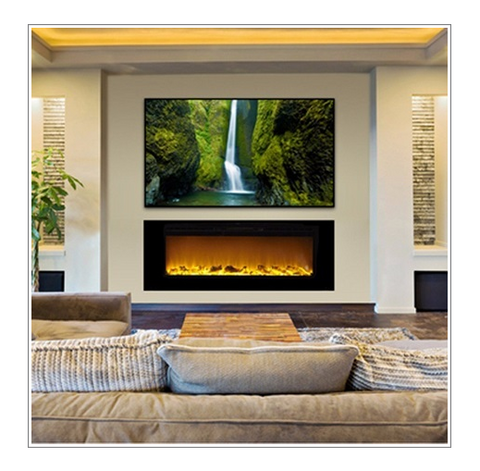
These fireplaces certainly give off a real fire look to varying extents, but they are not just about looks. Electric fireplaces are also heaters, so you are essentially getting the look and heat of real flames, but without any of the work or placement restrictions that would usually come along with it.
This is accomplished in any number of ways, which we’ll touch on further down.
So yes, “electric fireplace” is a bit of a misnomer, but you get the idea. As long as there is electrical operation, heat produced, and the look of flames (be it stationary or motion,) you have a true, legit electric fireplace.
Now let’s go over how we got here in the first place.
So, what is the deal with electric fireplaces? Are they really a good alternative? Why would anyone even use one in the first place? We’ll take on these questions below, while offering all the ins and outs one needs to know about electric fireplaces.
By the time you’re done reading this article, you should be up to speed on whether or not an electric fireplace is best for you, helping you move forward in the buying process, if applicable.
What Is An Electric Fireplace?
The term “electric fireplace” should already seem pretty self-explanatory, but allow me to elaborate some, for clarity’s sake.
Electric fireplaces are meant to mimic the look and feel of a real fireplace, but without the need to burn any type of wood, or use any combustibles. There is no actual “fire,” only various forms of fake fire that give off an authentic fireplace aesthetic.
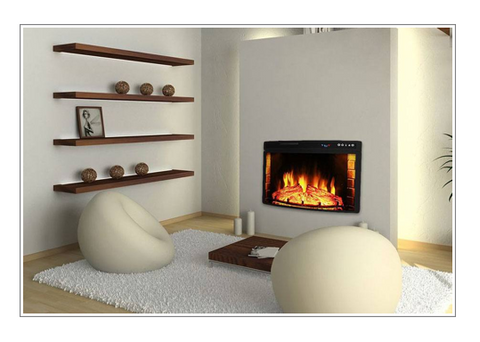
These fireplaces certainly give off a real fire look to varying extents, but they are not just about looks. Electric fireplaces are also heaters, so you are essentially getting the look and heat of real flames, but without any of the work or placement restrictions that would usually come along with it.
This is accomplished in any number of ways, which we’ll touch on further down.
So yes, “electric fireplace” is a bit of a misnomer, but you get the idea. As long as there is electrical operation, heat produced, and the look of flames (be it stationary or motion,) you have a true, legit electric fireplace.
Now let’s go over how we got here in the first place.
History Of Electric Fireplaces
The very first forms of electric fireplaces first began to pop up around 1912, which coincidentally was the same time that a number of electric appliances began to be mass produced for the average consumer.
These early forms were basically made using electric coils that were positioned in the front. When turned on, the coils would heat up, and heat would emanate. The orange glow evoked the feel of fire, and hence the name became associated.

(There are obviously still electric coil heaters in use today, but nobody refers to them as fireplaces anymore. They’re just heaters.)
The 1950s and 60s brought about some innovation to the electric fire world, and this is when companies really first started trying to create a sort of mock fire for improved visuals. The more realistic versions were mainly used for stage productions, however, with no heat produced.
The 1980s and 90s saw a resurgence of innovation towards electric fireplaces, and this is when the heating and visual functions really began to merge together for a more complete product. In 1995, one particular company obtained a patent for the first electric fireplace with realistic flame visuals.
Over the next two decades, multiple companies started to offer several different types of electric fireplaces, ranging from complete units made with a mantle, to entertainment centers with a unit in the middle. The visuals now use a combination of technologies and lighting to create the most realistic flames seen thus far. Some even have sound as well.
How Do Electric Fireplaces Work?
Electric fireplaces are actually very simple for the most part.
For the visual aspect, a number of different materials and techniques can be employed to create a realistic flame effect. For the most part, a combination of mirrors and LED lights are used to make everything from the flames, to the glowing embers on the fake logs.
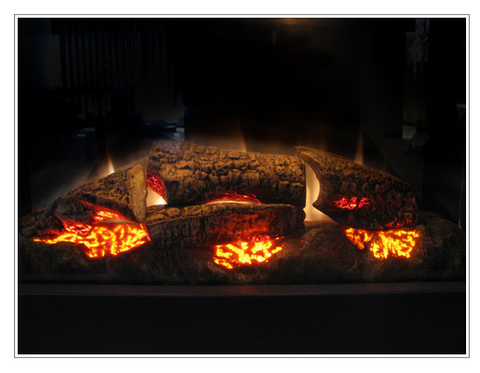
Some models may even produce a sort of mist that creates the look of small embers lifting upwards like you’d see on an actual fire. Other models use very thin pieces of fabric that move and sway around while being illuminated to create the flame effect.
As for the heating, there are two main options you’ll see the most often.
Forced Fan - The most basic of the two, a forced fan unit uses heating coils just like a normal electric heater, and then a fan blows the hot air out of the vents and into the room. These usually have a few different settings. And can generate a lot of heat depending on size.
Infrared Quartz - With this heating type, the heat is actually delivered through invisible infrared light. Rather than generate heat from coils and blow it outwards, infrared light from the quartz material warms the things it touches, whether it’s people or furniture.
Infrared quartz heat leaves the humidity in the air, creating a more comfortable home environment for those that don’t enjoy dry environments.
Types Of Electric Fireplaces
There are now more different types of electric fireplaces than ever before. Consumers can choose between units of many different sizes, and other models that can serve multiple purposes. Other models are meant to be a replacement for an existing fireplace.
Free-standing
Free-standing fireplaces are any type that isn’t affixed to something else. This can include smaller units that resemble the wood-burning ovens of yore, or larger models that serve bigger decor and functional purposes.
Mantel
Mantel electric fireplaces are any unit that comes built into an actual mantle. In most cases, these resemble old-fashioned fireplaces, and can often fool a visitor on first glance.
The mantel can be made from decorative wood, faux-wood, or even metal in some cases. The firebox itself is located where a fireplace would normally be when inside a built-in mantel inside a home. The heating element may or may not be separate from the flame part.
Mantel electric fireplaces are great for someone wanting a traditional fireplace look in a living room or bedroom. You get the standard mantle fireplace aesthetic, but with the freedom to “install” it anywhere.
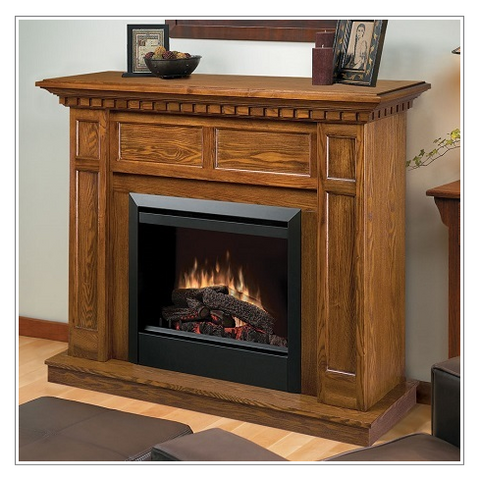
Entertainment Center
Similar to a mantel unit, an entertainment center electric fireplace has all of the normal parts of a common entertainment center, but with an electric fireplace on the bottom as a centerpiece.
The unit can include multiple shelves, drawers, and compartments, and usually accommodates a larger television, with room for audio devices and decor as well.
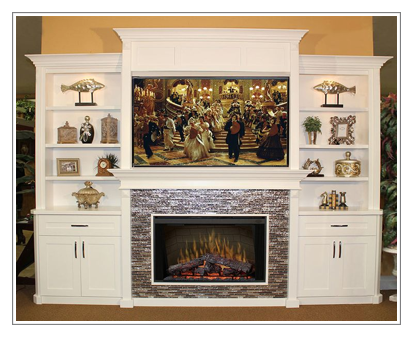
This is basically the most versatile type of electric fireplace, and can be used either as a sort of mantel, or as a way to add a warm feel and look to your living room, den, game room, or wherever else you’d like to have added heat and a realistic fire look with your entertainment setup.
Electric Stove
Electric “stove” fireplaces have the look and feel of the vintage wood-burning stoves that evoke the vibe of older homes, be it from a colonial era, or old European homes.
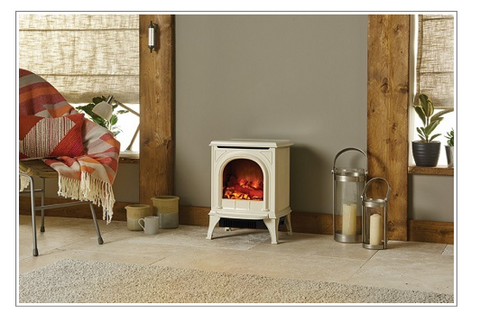
These stoves are mainly a decorative space heater that gives the room an alluring throwback look, but without having to worry about fumes, smoke, and changing out logs all the time.
You still get that free-standing stove style, and a good portion of the warmth that an actual wood-burning stove provides, all via an electrical outlet.
Wall Mount
Wall mount electric fireplaces are a more modern way to add some style to your space. These units are hung from a wall, and are usually very long and flat, sort of like a live piece of art that also provides heat.
The flat design and simple build of wall mounted electric fireplaces gives you a lot of choices as to where you can place it. Some may choose to hang it above a couch, while others may place it lower, perhaps a few inches above the floor.
The minimal, contemporary design of wall mount fireplaces makes them popular for both indoor and outdoor

installations. Those with covered patios may choose to mount one on the wall for some added warmth when enjoying the outdoors during cooler parts of the year.
The shape and style of wall mounted units also makes them good for temporary use during colder months, when style-conscious home dwellers want some added heat, but without the unappealing look of a basic space heater.
Electric Fireplace Inserts
Not every electric fireplace needs to be a free-standing type. There are plenty of other choices that involve insert-style units, allowing you to place an electric fireplace into an existing fireplace, or any spot that can house one.
Electric Firebox
As the name suggests, an electric firebox is a small, self-contained fireplace that you can place into an enclosed space, or even on top of something if possible. These are usually metal, and have a glass front and sides so you can see the flames.
These are often the size of a standard space heater, and produce a moderate amount of heat. Electric fireboxes generally have a traditional fireplace look, and mimic the use of a chimney, placing the fire a bit further back from the front.
Log Insert
Log insert electric fireplaces are the most “naked” type you’ll find. With these, all you get is the actual logs themselves, which are usually placed on top of an andiron, or log grate.

This creates the look of a real, open fire, and the andiron often has the heating element that emits the heat. Cheaper units only offer visuals.
With a log insert, you can place the unit in an existing fireplace, or one that is no longer active. This way, you can make use of the mantle or closed chimney, and still enjoy the look of burning logs, and extra heat for the room when needed.
Some may even use log insert electric fireplaces inside a real fireplace, substituting it for the times they don’t want to deal with getting logs for the fire, or the smoke and fumes. The size and design of log inserts gives them added versatility for those looking to be more creative.
Conclusion
So, there you go. Electric fireplace are very simple appliances that hold a wide range of uses, and unrivaled convenience when compared to standard fireplaces. The can be used anywhere in the home, require little upkeep, and are very economical for the most part.
Even if you enjoy using your conventional fireplace, an electric model still holds plenty of value and use for other parts of your home, inside and out.
Looking to buy an electric fireplace for your home? Be sue to check out our buying guide, where we’ll give you tips on how to choose an electric fireplace, and share our top picks.
Resources
